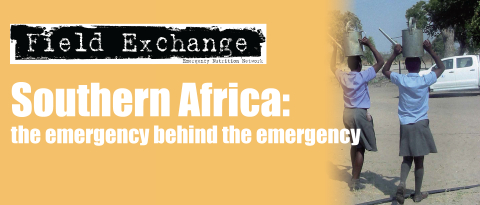Supplementary feeding using RUTF in Malawi
Summary of published research1

A study has recently been conducted to compare the clinical effectiveness of two supplementary feeding regimens in children at risk of malnutrition. The study took place in seven centres in rural Malawi. Being at risk of malnutrition was defined as weight-for-height <85%, but >80% of the international standard. A stepped-wedge design with systematic allocation was used for assigning children to receive either ready-to-use therapeutic food (RUTF) (n=331) or micronutrient-fortified corn/soy-blend (n=41) for up to eight weeks. Both regimens supplied quantities of food that were much larger than would actually need to be consumed by the children to achieve accelerated growth, and both the foods were simply distributed to mothers as dry rations. RUTF had the advantages of requiring no further preparation before consumption and having a high energy density, thus allowing for the consumption of small portions of the supplemental food to result in a substantial increase in energy intake. Furthermore, RUTF may not be subject to as much leakage as cereal/ legume-blends because such spreads are not usually part of the habitual diet. Therefore, other family members do not see it as food, but more as 'medicine'.
The primary outcomes were recovery, defined as weight-for-height >90%, and the rate of weight gain. Children receiving RUTF were more likely to recover (58% vs 22%; 96% confidence interval {CI} 20-52) and had greater rates of weight gain (3.1 g/kg . vs 1.4 g/kg.d; difference 1.7; 95% CI 0.8-2.6) than children receiving corn/soy blend. The results of this preliminary work suggests that supplementary feeding with RUTF promotes better growth in children at risk of malnutrition than the standard fortified cereal/legume-blended food.
The main limitation of the study was that participants were not randomly assigned to the two groups. Randomisation was not possible due to local belief systems of equity so that blatant differences would not easily be tolerated and also because of the limited resources of the Malawian health services which prevented creation of two parallel feeding options. In addition, blinding of staff and participants was impossible because of the obvious difference in appearance of the two types of foods. However, there is no evidence that bias resulted as the characteristics of the two dietary groups were similar upon enrolment.
Another limitation of the study was the large disparity between numbers in the two groups. Recruitment took place during the pre-harvest season when prevalence of malnutrition was at its highest. Thus, as the season progressed and food became more scarce, the number and severity of under-weight children increased. A stepped-wedge design was necessary to control for this seasonal variation, but its implementation resulted in a seven-fold greater number of children receiving RUTF. However, regression analyses performed to control for the effect of covariates indicated that type of supplementary food was an independent, significant determinant of the outcome.
The authors conclude that although supplementary feeding with RUTF may be a more effective alternative, larger-scale programmes often do not achieve the success seen in research studies so that data from use of RUTF as a supplemental food on a larger-scale are needed to evaluate its utility.
1Patel. M et al (2005). Supplemental feeding with Readyto- Use Therapeutic Food in Malawian Children at Risk of Malnutrition. J Health Popul Nutr, December; 23 (4): pp 351-357
Imported from FEX website


